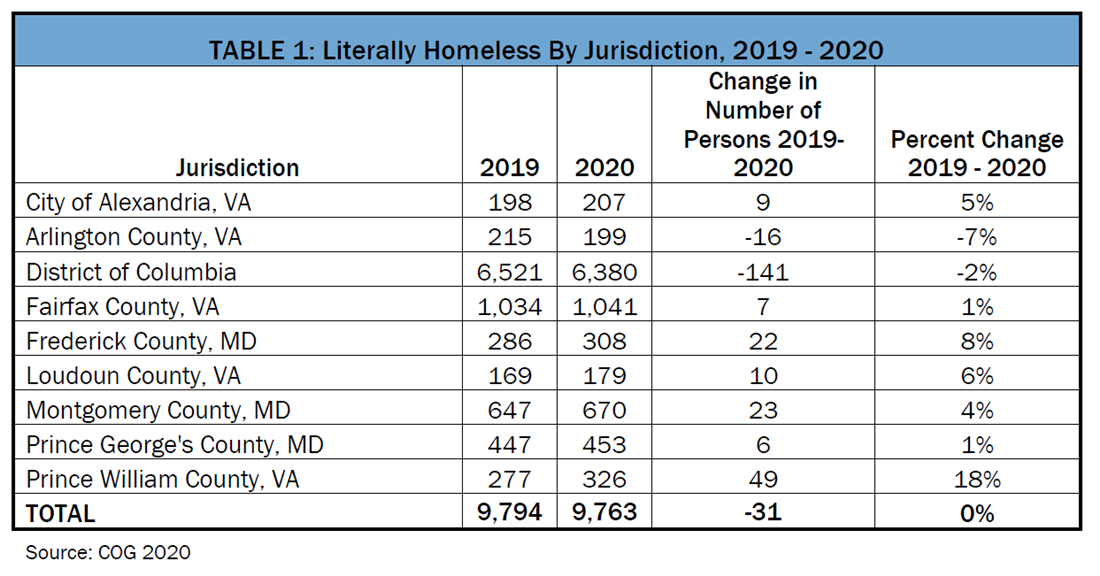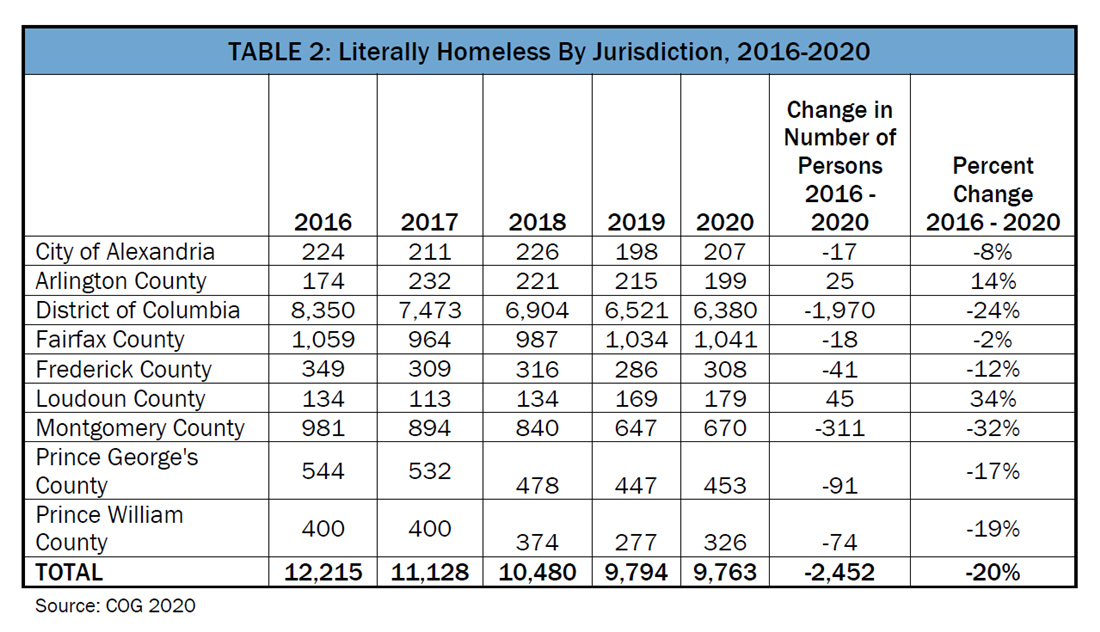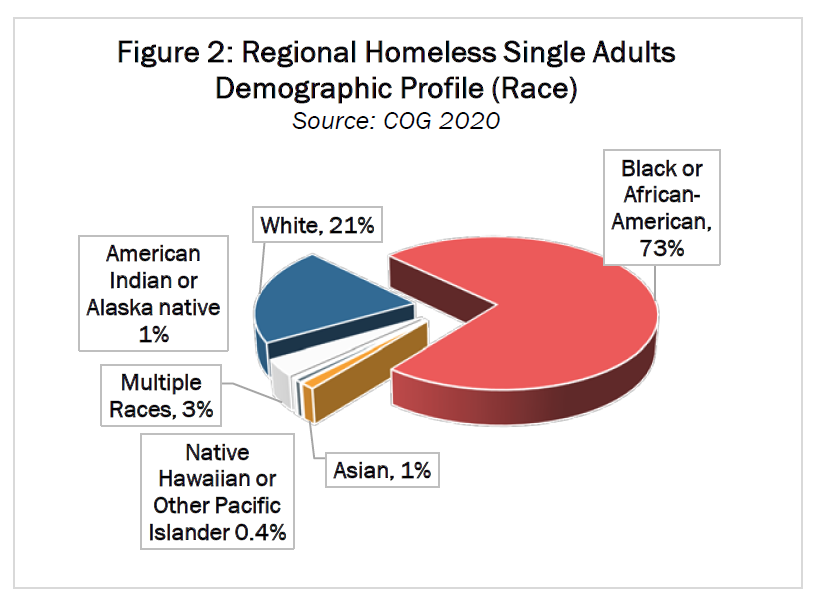According to a new report by the Metropolitan Washington Council of Governments (COG), there are 9,763 people experiencing homelessness in the region. This is the fewest number of people counted since the region began coordinating on the annual enumeration in 2001.
The report, Homelessness in Metropolitan Washington, is a one-day snapshot of the region’s residents experiencing homelessness and contains data from nine area jurisdictions.
“The region’s dedication to addressing its pervasive issue of homelessness has resulted in measurable progress,” said Derrick L. Davis, COG Board Chair and Prince George’s County Council Member. “However, COVID-19 has only exacerbated the region’s housing challenges, and we’ll need to double down on our commitment to identify housing solutions, among other critical actions, to continue to meet this growing need in our communities.”
The annual enumeration was conducted in January, before the impact of the pandemic caused by COVID-19 was apparent in the region. However, according to those working to address the challenges facing people experiencing homelessness, the housing crisis has grown significantly as a result.
“COVID-19 has made it clear: housing is health care,” said Kim Ball, Montgomery County Department of Health and Human Services Homeless Services Administrator and COG Homeless Services Committee Co-Chair. “And with coordinated local and regional action to prevent and end homelessness, we can solve our neighbor’s housing crisis and decrease the spread of COVID-19. As the results from the 2020 Point-in-Time (PIT) count demonstrate, a housing first approach and use of a by-name Coordinated Entry System can make the experience of homelessness rare, brief, and one-time only.”
RESULTS AT THE LOCAL LEVEL
Two of the nine participating metropolitan Washington jurisdictions recorded decreases in the number of persons experiencing homelessness from 2019 to 2020.
The District of Columbia recorded the greatest reduction in the number of persons experiencing homelessness from 2019 to 2020 (141 fewer individuals), followed by Arlington County (16 fewer persons).
The region recorded a 20 percent decline—2,452 fewer people, experiencing homelessness over the last five years. These longer-term trends are particularly encouraging at the local level; seven of nine jurisdictions experienced decreases in the number of people experiencing homelessness during this time period. The District of Columbia, Montgomery County, and Prince George’s County recorded the largest decreases.
FAMILIES, CHILDREN, AND SENIORS
The PIT report provides extensive data on families and many subpopulations. For example, for the third year in a row, the number of families experiencing homelessness decreased, down four percent from 2019, bringing the regional total of homeless families to 1,191. Children represent nearly a quarter of the region’s total homeless population (2,226), decreasing slightly from the year prior.
Additionally, data was analyzed on the growing number of senior citizens facing a housing crisis or seeking emergency shelter in the region—886 people, including 137 unsheltered persons on the night of the count. The oldest senior experiencing homelessness was 93 years old.
RACIAL INEQUALITY
Fifty-four percent of the region’s population is white, and 25 percent is African American or Black. Still, of the 5,987 homeless single adults who responded to demographic questions on the night of the 2020 count, 73 percent responded that they were African American, 21 percent white, three percent as multiple races, and one percent as Asian.
With the exceptions of Frederick and Loudoun Counties, the report notes that persons experiencing homelessness in the region are disproportionately more likely to be Black or African American, reflecting a long history of racial segregation and discrimination in the United States that continues to impact people of color to this day.
REGIONAL CHALLENGES
Metropolitan Washington continues to face significant challenges in its efforts to end homelessness. The report cites the insufficient supply of affordable and available housing opportunities for the lowest income households as “the greatest barrier to ending homelessness.” Rising rents and stagnant wages are also contributing factors.
According to the report’s analysis of federal unemployment forecasts for 2020, homelessness could increase by as much as 40 percent nationwide this year.
“Homelessness was a serious challenge in our region pre-pandemic, but the COVID-19 impact brings new urgency to addressing the crisis,” said Tony Turnage, Prince William County Assistant Director of the Homeless Services Division and COG Homeless Services Committee Co-Chair. “It’s clear, housing must be central to the conversations about the region’s recovery plans.”
The report also calls on jurisdictions to continue efforts to reach out, assess, and house unsheltered homeless persons, increase permanent supportive housing, rapid rehousing, and other permanent housing inventory, provide training opportunities to low-skilled and low-wage workers and ensure that solutions are centered in racial equity. Housing affordable for all income levels must also be available across the region.
The report was compiled by the COG Homeless Services Planning and Coordination Committee. Participating jurisdictions are: the City of Alexandria; Arlington County; the District of Columbia; Fairfax County, including data from the City of Falls Church and the City of Fairfax; Frederick City and County; Loudoun County; Montgomery County; Prince George’s County, including data from the City of Bowie; and Prince William County, including data from the City of Manassas and the City of Manassas Park.
MORE: Homelessness in Metropolitan Washington: Results and Analysis from the Annual Point-in-Time (PIT) Count of Homeless Persons